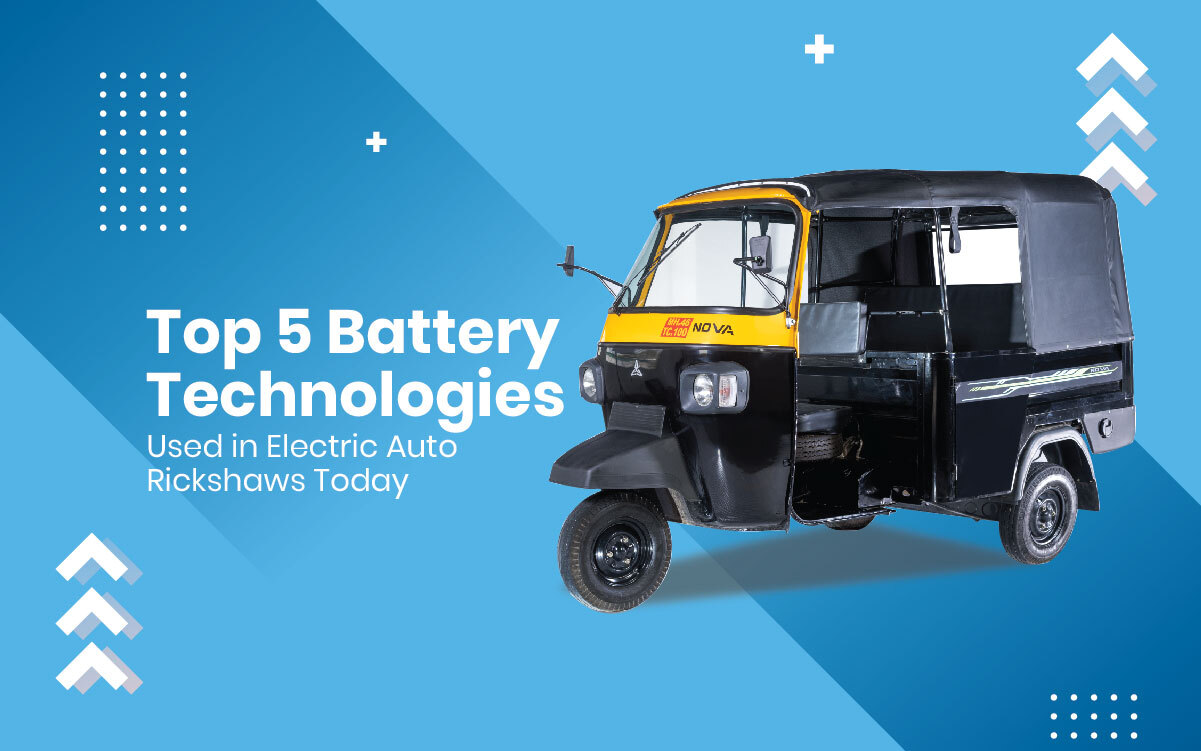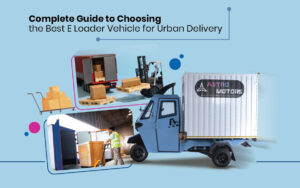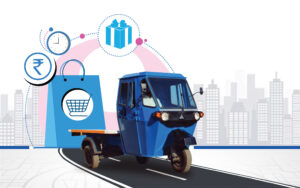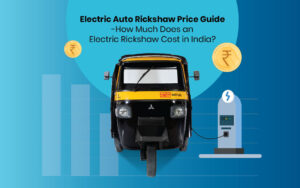Wondering which electric rickshaw battery powers the future of mobility? Here’s a breakdown of the top 5 technologies driving modern battery auto rickshaws in India.
Key Takeaway Summary
- Electric rickshaw batteries determine performance, cost, and lifespan.
- Popular types: Lead-Acid, Lithium-Ion, LFP, NMC, and Gel Batteries.
- Battery auto rickshaw adoption is rising due to subsidies and low running cost.
- Astro Nova Electric Rickshaw features a 10.24 kWh battery offering 218 km range.
- Choosing the right battery impacts payload, speed, and durability.
Why Electric Rickshaw Battery Technology Matters
The electric rickshaw battery is the heart of a battery auto rickshaw. It dictates not only the range per charge but also the vehicle’s durability, cost efficiency, and overall user experience. As India embraces clean mobility, advanced battery technologies are ensuring that e rickshaws can serve as reliable last-mile solutions.
1. Lead-Acid Batteries – The Traditional Choice
For years, lead-acid batteries have powered the majority of battery rickshaws in India due to their low upfront cost.
- Pros: Affordable, widely available, and easy to recycle.
- Cons: Heavy, lower lifespan (300–400 cycles), longer charging times.
- Use Case: Suitable for budget-conscious buyers prioritizing low purchase cost.
| Parameter | Lead-Acid Battery |
| Cost | Low (₹25,000 – ₹40,000) |
| Lifespan | 1–1.5 years |
| Weight | Heavy |
| Charging Time | 7–8 hours |
2. Lithium-Ion Batteries – The Modern Standard
Lithium-ion (Li-ion) batteries have become the most popular option in battery auto rickshaws thanks to their high energy density and fast charging ability.
- Pros: Lightweight, long life (1,000–1,500 cycles), fast charging.
- Cons: Higher upfront cost.
- Use Case: Drivers covering longer routes who need reliability and lower running costs.
| Parameter | Lithium-Ion Battery |
| Cost | Higher (₹60,000 – ₹1,20,000) |
| Lifespan | 4–5 years |
| Weight | Light |
| Charging Time | 2–4 hours |
3. Lithium Iron Phosphate (LFP) Batteries – Safety First
Among lithium-based options, LFP batteries stand out for their thermal stability and safety. These are increasingly being adopted in electric rickshaws.
- Pros: Excellent safety, long cycle life (2,000+ cycles), stable performance.
- Cons: Slightly heavier than NMC batteries.
- Use Case: Fleet operators needing durability and safety assurance.
Astro Nova electric rickshaw is powered with Lithium Iron Phosphate battery benefiting the users with a very high life span and optimal safety.
| Parameter | LFP Battery |
| Cost | Medium-High |
| Lifespan | 5–7 years |
| Safety | Very High |
| Energy Density | Moderate |
4. Nickel Manganese Cobalt (NMC) Batteries – High Performance
NMC batteries are known for their high energy density, making them suitable for premium battery auto rickshaws.
- Pros: Lightweight, excellent performance, long range per charge.
- Cons: Expensive and slightly less safe than LFP.
- Use Case: Ideal for urban mobility solutions demanding speed and extended range.
| Parameter | NMC Battery |
| Cost | High |
| Lifespan | 5+ years |
| Energy Density | High |
| Charging Time | 2–4 hours |
5. Gel Batteries – Low Maintenance Option
Gel batteries are an advanced version of lead-acid batteries where silica gel is used as the electrolyte. They are gaining traction in budget battery rickshaws.
- Pros: Low maintenance, spill-proof, better performance than standard lead-acid.
- Cons: Heavier than lithium options, shorter lifespan.
- Use Case: Affordable choice for small-scale operators with limited routes.
| Parameter | Gel Battery |
| Cost | Medium |
| Lifespan | 2–3 years |
| Maintenance | Low |
| Charging Time | 6–8 hours |
Spotlight on Astro Nova Electric Rickshaw
Among modern battery auto rickshaw options, the Astro Nova Electric Rickshaw from Astro Motors demonstrates how cutting-edge LFP battery technology enhances real-world performance.
Key Highlights of Astro Nova:
- Battery Capacity: 10.24 kWh
- Range: 218 km per charge
- Top Speed: 55 kmph
- Payload: 435 kg
Unlike conventional rickshaws, Astro Nova’s advanced battery system ensures longer routes, higher passenger comfort, and reduced downtime. It represents the shift from basic lead-acid batteries to next-generation lithium-based solutions that offer both performance and efficiency.
Astro Nova Electric Auto Rickshaw: Specs, Features & Price Breakdown (2025)
Why Battery Choice Matters for Rickshaw Owners
The battery technology you choose directly impacts:
- Daily earnings (through range & charging downtime)
- Maintenance costs (longer lifespan reduces replacements)
- Passenger experience (smooth ride, reliability)
- Business sustainability (eco-friendly and subsidy benefits)
For operators who want maximum return on investment, a lithium-based battery auto rickshaw like Astro Nova provides the best balance of affordability and long-term savings.
Future Trends in Electric Rickshaw Batteries
- Solid-State Batteries: Expected to deliver higher energy density and ultra-fast charging.
- Battery Swapping Models: Emerging as a solution for reducing downtime.
- Recycling & Second-Life Use: More focus on sustainable battery ecosystems.
The industry is rapidly moving toward longer-lasting, safer, and greener battery tech, aligning perfectly with India’s EV adoption goals.
Explore 7 Key Benefits of Owning a Battery-Powered Auto Rickshaw
FAQs on Electric Rickshaw Battery
Q1. Which battery is best for a battery auto rickshaw?
Lithium-ion and LFP batteries are considered the best due to their long life, fast charging, and safety.
Q2. What is the cost of an electric rickshaw battery in India?
Battery costs vary: Lead-acid (₹25,000–₹40,000), Lithium-ion (₹60,000–₹1.2 lakh).
Q3. How long does an electric rickshaw battery last?
Lead-acid lasts 1–1.5 years, while lithium batteries can last 4–7 years depending on usage.
Q4. Does Astro Nova Electric Rickshaw use advanced battery technology?
Yes. With a 10.24 kWh battery and 218 km range, Astro Nova leverages next-gen lithium technology for efficiency and durability.
Q5. Are subsidies available on battery auto rickshaws?
Yes. Under FAME-II, buyers benefit from reduced purchase costs on electric rickshaws.
Conclusion
The type of electric rickshaw battery determines how efficient, durable, and profitable your battery auto rickshaw will be. From budget-friendly lead-acid to advanced lithium-based solutions, technology is evolving fast.
With innovations like those in the Astro Nova E-Rickshaw, operators now have access to longer ranges, higher payloads, and better ROI. Choosing the right battery today means driving the future of sustainable mobility tomorrow.




